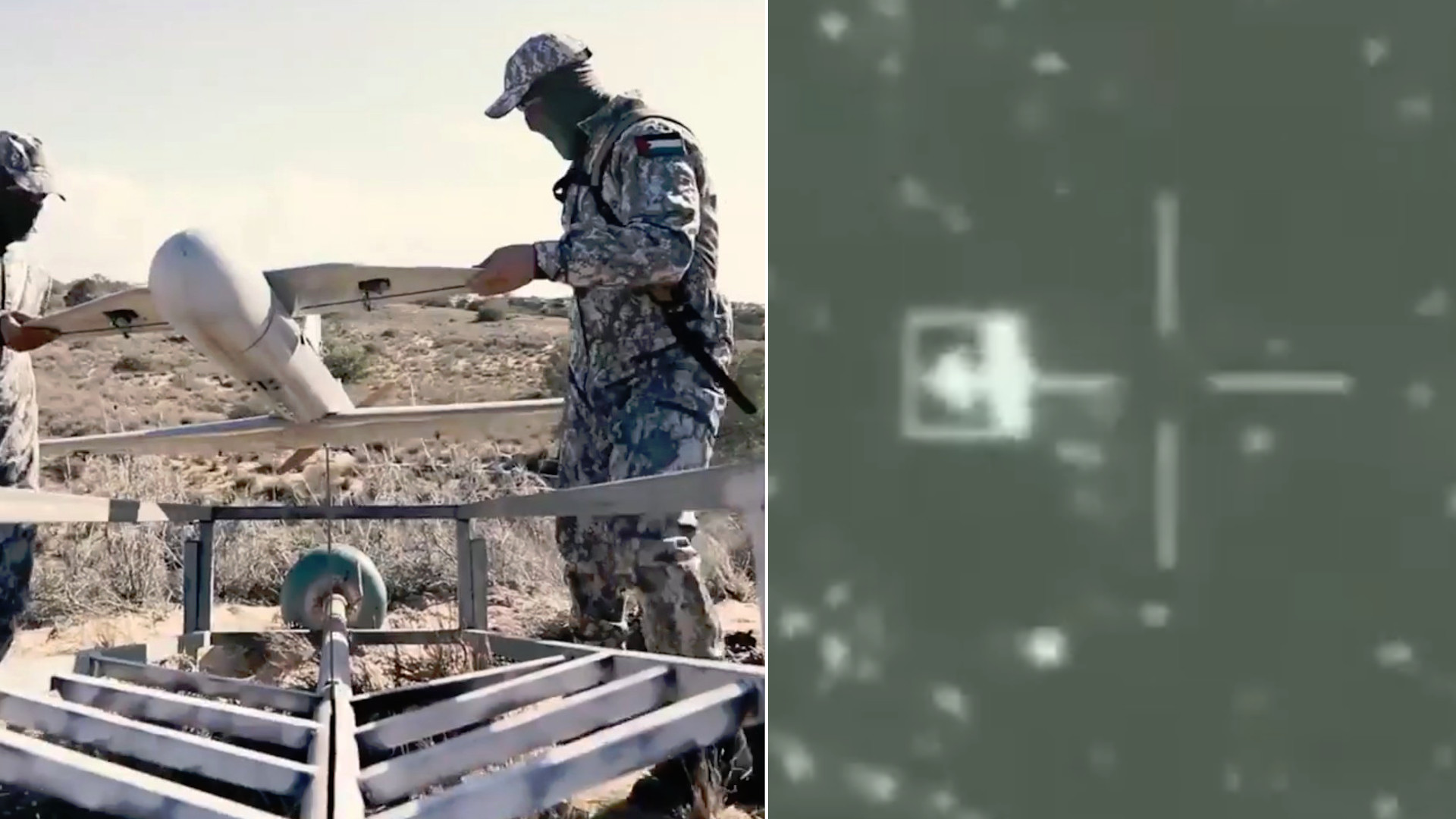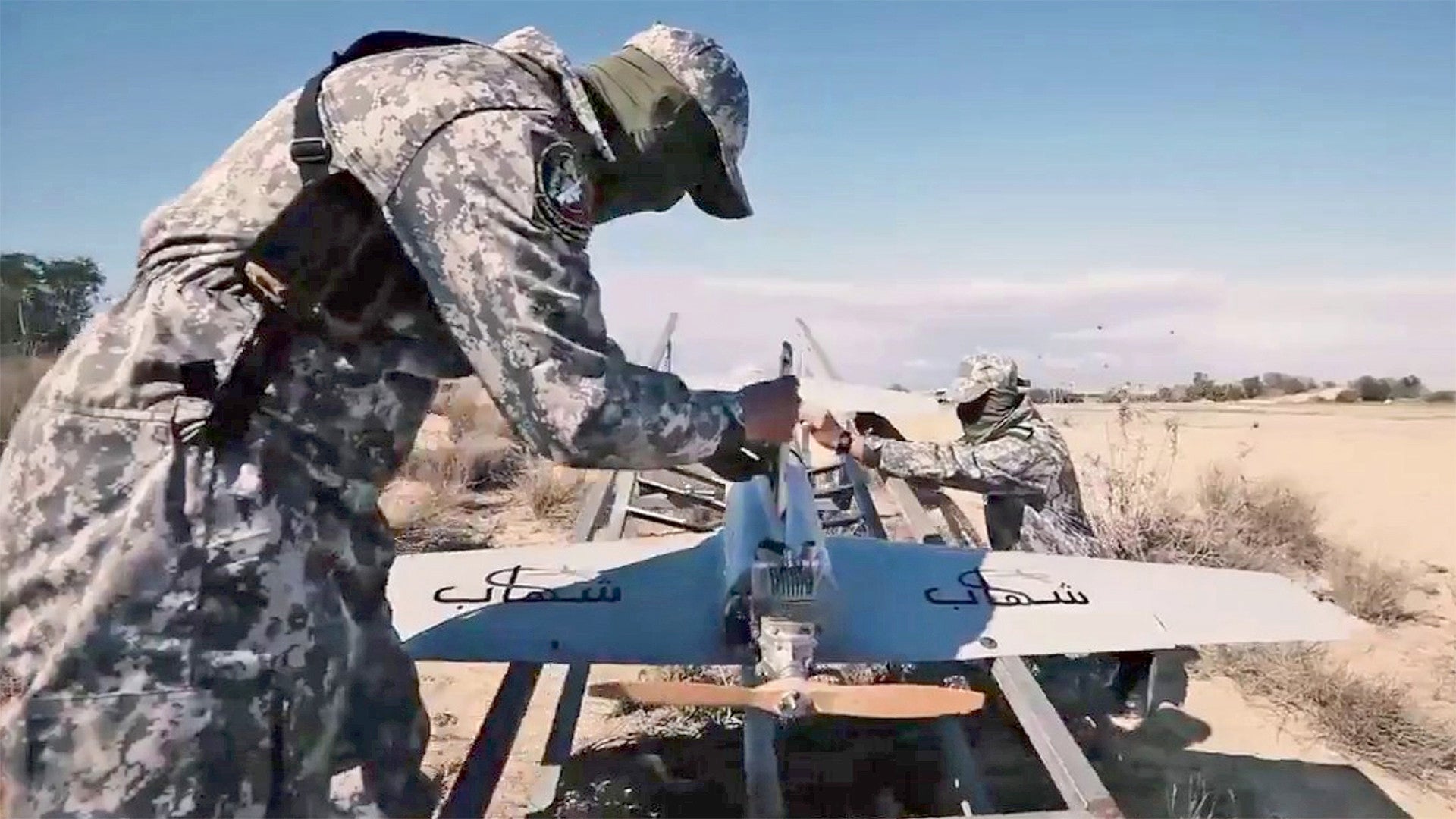After days of firing massive rocket barrages at Israel from the Gaza Strip, which have overwhelmed Israel’s Iron Dome defense systems, Palestinian militants have begun employing a new weapon: Shehab suicide drones. Hamas’ militant wing, the Al Qassam Brigades, says that these were developed and built locally, but, while they are smaller, they also have some broad similarities to designs of Iranian origin that have been employed extensively by the Houthis in Yemen.

The first image of Shehab, which Hamas does not appear to have previously disclosed the existence of, came in a video, shot using some kind of infrared targeting system or some other kind of full-motion video camera on an aircraft, that the Israel Defense Forces (IDF) released of one of these drones being shot down earlier today. The Al Qassam Brigades subsequently released their own undated video showing militants handling and then launching Shehabs.
The use of these unmanned aircraft is now a component of some of the worst fighting between Palestinian militant groups and the IDF in years, which you can read more about here and that is still escalating. Unguided rockets of various types remain the weapon for choice for the Al Qassam Brigades, as well as Palestinian Islamic Jihad, which have, together, now fired more than 1,700 rockets at Israel from Gaza in the past three days. This in turn has prompted retaliatory Israeli air and artillery strikes, including numerous targeted killings. One of those targeted operations was carried out earlier today against the home of Samer Abu-Daka, the head of Hamas’ drone units.
The IDF had already reported intercepting drones flying from Gaza, as well as striking drone launch units there, in the course of the recent fighting. However, it is unclear if any of those previous instances involved the Shehab.
The exact origins of the Shehab, a relatively small pusher-prop design with a tubular central fuselage, a low-mounted rear wing, and a high-mounted canard-type forward wing, are unclear. While Hamas’ claims it is entirely indigenous development, this drone’s general configuration, at least externally, is similar in some respects to the Houthis’ Qasef-series, as well as the Iranian Ababil-T, from which the former is at least derived.
Experts and observers have, however, already noted that there the Shehab is not a one-for-one copy of members of the Qasef family or the Ababil-T. For one, Shehab appears to be notably smaller overall. The exact size and shape of its wings are different from the Houthi and Iranian designs and its nose cone is notably blunter, too.
There are some clear similarities between the Shehab’s engine and the ones found on Qasef-series drones. At the same time, The Daily Beast‘s Adam Rawnsley, who has been following Iranian and Iranian inspired drone developments closely for years now, noted on Twitter that a United Nations panel of experts, as well as Conflict Armament Research, an independent organization, have said that those Houthi unmanned aircraft use various engines that are readily available on the commercial market.
There are no clear views of the marking on the servo motors that move the control surfaces on the Shehab, or other internal components, which have provided evidence of Iranian ties to other drone designs recovered overseas in the past. Hamas’ drone design also has a visible commercial GPS module, which would almost certainly be used to send it to a specific fixed location using preprogrammed coordinates, but there’s no clear indication, one way or another, if that came by way of Iran.
Of course, Shehab’s distinct qualities do not preclude some kind of Iranian involvement or influence in its design. There have also already been indications from Yemen that the regime in Tehran may provide distinct derivatives of its own drones and missiles, or designs for them, to foreign proxies, possibly to provide plausible deniability. It’s also not necessarily surprising that Shehab is smaller than the Qasef or Ababil-T designs, the distances involved in attacking Israel from Gaza are much shorter than those between launch sites in Yemen and targets in Saudi Arabia, for instance.
“What we now have in theatres like Gaza and Yemen is a concerted Iranian effort to enable the local production of rather simple systems which seem to be specially designed with that purpose in mind. Add to that local autonomy and sub-standard manufacturing,” Fabian Hinz, an independent analyst who worked as a research associate at the James Martin Center for Nonproliferation Studies in the past, wrote on Twitter. “Other systems (like the Yemeni Quds cruise missile or the 358 SAM) seem to be smuggled to proxies from Iran but haven’t been unvealed [sic] in Iran proper (either to maintain deniabiltiy [sic] or because they are custom-tailored to proxy use and not in service with Iran itself).”
“The result of both of these trends is that you have systems that look very Iranian in style but are not identical to anything you see in glossy Iranian IRGC footage,” he continued. “So often, instead of looking for matching nuts and bolts look (as you would do for example to identify an exported American missile) it makes more sense to look for signature design features, components and plausability [sic] instead.”
“So is it possible that Hamas is cobbling together crude airframes locally and slapping Iranian-transferred electronics in there? Yep,” Rawnsley also wrote on that social media site. “Is it possible they’re just making Iranian inspired drones? Yep.”
Regardless of the exact origins of Shehab, it underscores the continued proliferation of lower-end, but nevertheless threatening small unmanned aircraft, including suicide drones and types designed to drop improvised munitions. These present very distinct challenges for defenders compared to more traditional weapons, such as artillery rockets, which generally follow more predictable higher-angle ballistic trajectories, making it easier to spot, track, and potentially intercept them.
As already noted, Israel’s Iron Dome defense systems, which are designed primarily to counter lower-end threats, such as rockets and small drones, have been heavily taxed in the recent fighting with Palestinian militants in Gaza. In addition, the video that the IDF released strongly suggests an aircraft was used to intercept at least one of the Shehabs.
Using fixed-wing aircraft or helicopters to bring down these drones highlights a significant cost disparity that has also been visible in and around Yemen, as well, with Royal Saudi Air Force F-15 combat jets, which are already not cheap to operate, regularly employing very expensive air-to-air missiles to knock down much lower-cost Houthi Qasefs.
All of this is only further evidence of the very real threat that these unmanned systems present, even to advanced, nation-state military forces, something that has been clear for years now, as The War Zone
has highlighted on numerous occasions. That Hamas, which operates in the Gaza Strip under one of the most intensive blockades anywhere in the world, can field this kind of capability, on any level, underscores just how low the barrier to entry is and how the use of suicide drones and other small unmanned aircraft is only set to keep growing, including among non-state actors, as time goes on.
With no clear end in sight to this current conflict between Palestinian militant groups in Gaza and Israel, we are likely to see more demonstrations of the size and scope of Hamas’ drone arsenal and just how effective it might be.
Contact the author: joe@thedrive.com
